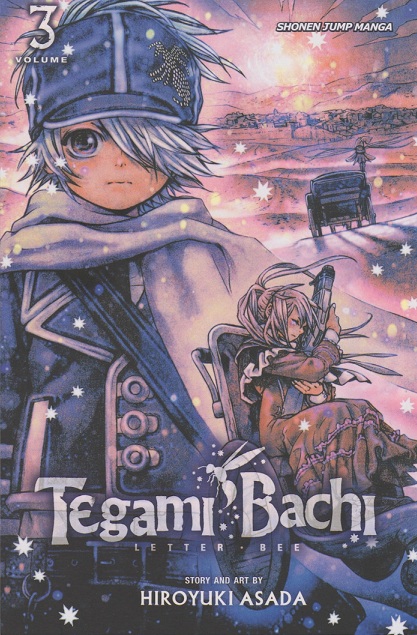 Title: Tegami Bachi: Letter Bee
Title: Tegami Bachi: Letter Bee
Author: Hiroyuki Asada
Publisher: Viz Media (Shonen Jump)
Volume: Volume 3 (ongoing), $9.99
Vintage: 2008 by Shueisha in Japan, September 2010 by Viz Media
Genre: Fantasy, drama, action, supernatural, steampunk, adventure
Amberground is a land of perpetual darkness. A man-made sun provides a small amount of light, fully lighting the capital, but fading in the outer lands, where a boy named Lag Seeing lives. Lag Seeing was a letter being delivered by Letter Bee Gauche Suede when they were attacked by Gaichuu – giant metal insects. Gauche saved Lag, and shared his story about wanting to become Head Bee so he can earn enough money to cure his paraplegic little sister. After Lag was safely delivered, he decided to become a Letter Bee as well, following the path of Gauche, whom he now greatly admired. On his way to Letter Bee headquarters to take his test, he met a girl named Niche, and saved her from a Gaichuu. Niche decided to stay with Lag and became his dingo, or bodyguard.
Lag passed his Letter Bee test with flying colors, but soon learned that his hero, Gauche, was no longer a Letter Bee. Gauche had gone out on a delivery and never returned. Shocked, Lag set out to find some answers, and seeks out Gauche’s sister, Sylvette. Unfortunately, Sylvette doesn’t have any answers. She only has a letter of dismissal, removing Gauche from the Letter Bee roster for failing to show up for deliveries, or at the main Beehive, and for having cut off all contact with the Letter Bees. Sylvette claims that her brother lost his heart when he moved away after a recent promotion, and all she has left of him is his gun, Nocturne No. 20. Bitter and heartbroken, feeling that her brother abandoned her, Sylvette sends Lag away. But after a few kind words from Niche, Lag heads back, determined to convince Sylvette that Gauche is still alive, and give her renewed hope by promising to find him for her. As Lag resonates with Gauche’s weapon, Gauche’s memories play back for Lag and Sylvette, showing his pride as a Letter Bee, willing to risk his life to bring people’s hearts together across distances. With a torrent of tears, Lag promises to bring Gauche back and return his heart to him, prompting Sylvette to obey her brother’s wish to give Nocturne No. 20 to Lag. Before his first assignment as an official Letter Bee, Assistant Director Aria arrives to escort Lag, and tells him about the Flicker from twelve years ago, when the man-made sun lost its light for a brief time, causing many people to lose their memories…including Gauche. She warns him of being too ambitious before he sets off to assist fellow Letter Bee Zazie. He is soon entrusted by Director Largo to deliver a package to a former Letter Bee in Yodaka, which he will be guided to by an old dingo named Darwin. Lag learns of the true loyalty of dingos, and how even the darkest parts of the land can sparkle with warmth from the hearts of those that live there.
I can see why so many have fallen in love with this series, though it doesn’t do much for me personally. The one thing I am really intrigued by is its Chopin references. A former famed weapon maker is named after the late composer, and Gauche’s weapon (made by the aforementioned craft master) is named after one of Chopin’s famous piano pieces. A scholar of Chopin could draw some connections here, as Nocturne No. 20 was dedicated to Chopin’s sister, and suggest that Gauche chose his weapon to protect his own sister, and to help him attain his goal of curing her. The steampunk setting reminds me of the video game Eternal Sonata, which heavily drew on Chopin’s life and music (and indeed featured him as a playable character). There’s also the town that Lag must pass through, George’s Little Village, which according to Asada was the home of female writer George Sandstorm, a reference to author and Chopin’s lover George Sand, and the story of Sandstorm and the weaponsmith parallels that of the real George and Chopin. I’m curious to know if the Chopin references are a recurring theme, or just something tossed in here or there (maybe Asada is a Chopin fan). Unfortunately, that’s all that really jumped out at me, and it’s such a small thing.
The story is rather melancholy. Its setting, a land of almost complete darkness, makes its infestation of giant bugs all the more menacing. The Gaichuu aren’t the only dangers, as the land itself proves dangerous, with crumbling cliffs, deserted expanses, exposure to the elements, and an anti-government uprising. The life of a Letter Bee is incredibly dangerous, and the higher up in the ranks you go, the more dangerous it gets, with more advanced deliveries. The powerful weapons they use draw on a user’s heart and memories, and the inexperienced can easily destroy themselves. The mythology is certainly interesting, though there doesn’t appear to be a lot of depth. I will say that the art is quite beautiful. (Asada’s work can also be seen in Range Murata’s gorgeous Robot anthology.) The style fits a story that is mostly about children, though when the adults show up, there’s an obvious difference and a more mature design. With a focus on emotions and the heart, Letter Bee doesn’t feel like the average Shonen Jump title, as the action tends to take a back seat to the characters’ personal journeys.
There’s a 25-episode anime that aired from October 2009-March 2010 from Studio Pierrot (and a second season is currently airing), which can be watched streaming on Crunchyroll.com.
Kris
kristin@comicattack.net
@girlg33k_Kris
Review copy provided by Viz Media.


Pingback: Tweets that mention Bento Bako Weekly: Tegami Bachi: Letter Bee vol. 3 -- Topsy.com
Pingback: Viz nabs TenTen! « MangaBlog
Pingback: Bento Bako Weekly: (Mostly) Manga Gift Guide
Pingback: Bento Bako Weekly: Tegami Bachi: Letter Bee 4&5